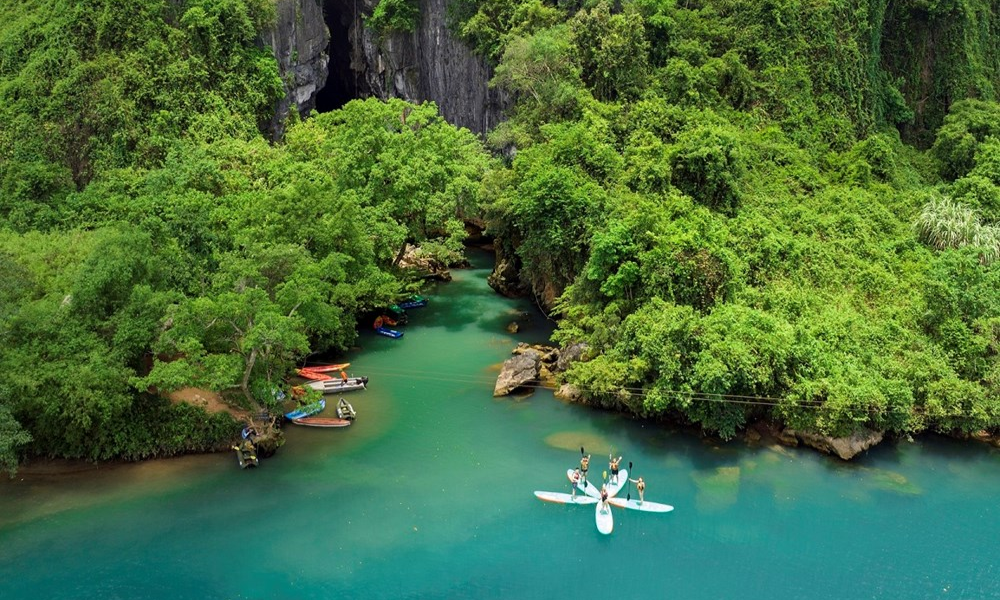
Quang Binh province is located in the North Central region, bordering Ha Tinh to the north, Quang Tri to the south, Laos to the west and the East Sea to the east. The capital of Quang Binh is Dong Hoi city, in addition there is Ba Don town and the districts of Bo Trach, Le Thuy, Minh Hoa, Quang Ninh, Quang Trach, Tuyen Hoa.
Best Time to Visit Quang Binh
Quang Binh's climate is divided into two distinct seasons, the rainy season from September to March of the following year, the dry season from April to August. In addition, from November to around March, the temperature in Quang Binh also decreases, fluctuating around 17-22 degrees Celsius. The best time to come here is from around the end of March to the beginning of September.
Traveling in the rainy season, you will have limited mobility, in addition, swimming and cave exploration activities are also difficult to do. However, for those who love to explore, Quang Binh in the rainy season has its own interesting features. You can wade through rivers and streams, kayak and SUP in Minh Hoa district, from August to November.
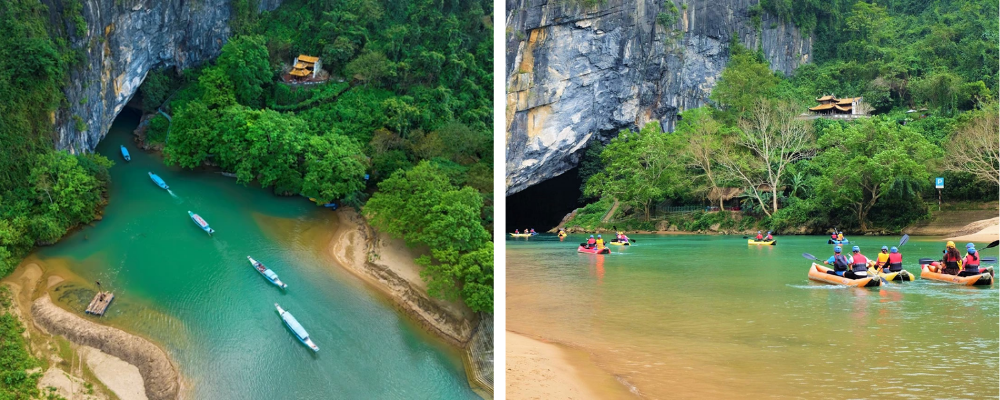
Move
Dong Hoi City is about 500 km from Hanoi and about 1,000 km from Ho Chi Minh City. There are many means of transportation to Dong Hoi City, convenient for tourists.
There are direct flights from Hanoi and Ho Chi Minh City to Dong Hoi with round-trip fares ranging from 2 to 3 million VND. Flights to Quang Binh are not frequent, usually only 2 flights per day. Flight time from Hanoi to Dong Hoi is nearly 1 hour, from Ho Chi Minh City to Dong Hoi is nearly 2 hours.
Dong Hoi Station is the stop for all Thong Nhat, SE or QB trains. One-way train fares range from 450,000 to 1.4 million VND per person depending on class and seat or sleeper.
Many bus companies have routes to Quang Binh, running at night or during the day. From Hanoi to Dong Hoi City, there are Hung Long, Hoang Linh, Phuong Trang, Dong Hien with one-way ticket prices of 300,000-500,000 VND per person. Travel time is about 8-9 hours. From Ho Chi Minh City, there are Hoang Long, A Ba, Loc Thuy buses with one-way ticket prices of 400,000-800,000 VND per person. Travel time is about 20 hours.
By private car, visitors can travel along National Highway 1A or Ho Chi Minh Road. Currently, many sections have expressways, shortening travel time. From Hanoi to Dong Hoi is about 10 hours if there is no traffic jam and a short break. Note that on the first and last days of holidays, the roads are often congested, especially at the gateway to Hanoi.
If you want to see the scenery, you can travel along Ho Chi Minh Road. The shortest section connecting National Highway 1A and Ho Chi Minh Road is in Quang Binh. Note that phone signal may be lost in some places on this route and drivers need to comply with speed regulations and pay attention when passing through residential areas. Travel time is 2-3 hours longer than National Highway 1A, there are no toll stations. Ho Chi Minh Road takes visitors along the Truong Son mountain range, through famous national parks such as Phong Nha - Ke Bang, Cuc Phuong forest.
In Quang Binh province, hire a taxi or rent a tourist car on Le Loi, Tran Hung Dao, Huu Nghi streets... in Dong Hoi city. Motorbikes can be rented at hotels, 100,000 - 150,000 VND per day.
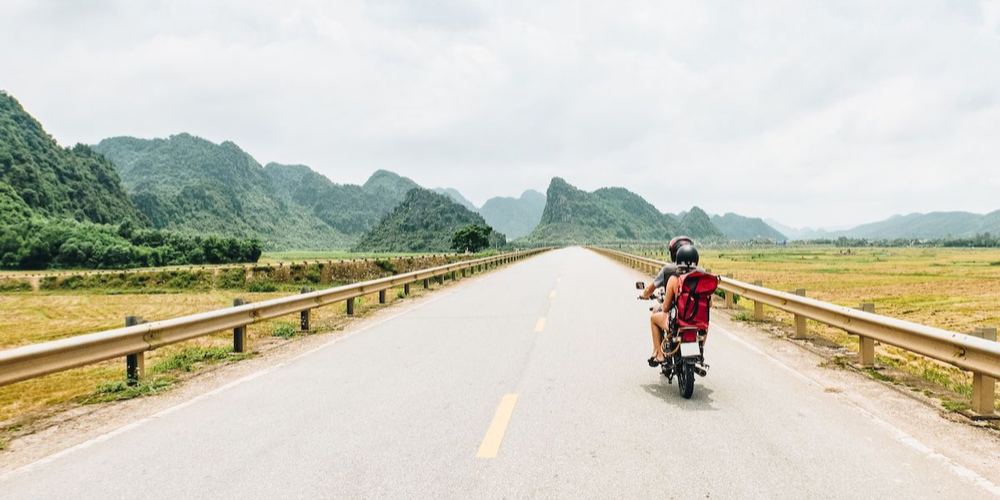
Accommodation
Accommodation services in Quang Binh are developed and have many options from hotels, motels to homestays, farmstays or camping.

In Dong Hoi, you can choose to stay in the city center such as Ly Thuong Kiet Street, Tran Hung Dao Street or hotels with beautiful locations near Nhat Le Beach on Truong Phap Street. 4-5 star hotels in the city include Meliá Vinpearl Quang Binh, Muong Thanh Holiday, Muong Thanh Luxury Nhat Le, Sun Spa Resort, Celina Peninsula Resort, Gold Coast, Saigon Quang Binh... with prices ranging from 600,000 VND to 2 million VND per night.
In Le Thuy, Quang Trach, Bo Trach, Minh Hoa districts, there are tourism exploitation and also accommodation, with a variety of prices.
Specifically, in the Phong Nha - Ke Bang National Park area (Bo Trach district), visitors should choose resorts close to nature such as Chay Lap Farmstay, Nguyen Shack - Phong Nha Eco, Phong Nha Coco Riverside, Phong Nha Lake House, Lucky Home... Each night here costs from 400,000 to 2 million VND per room for two people.
Blue Diamond Camp offers many experiences that make visitors feel like they are exploring Son Doong Cave, with an underground swimming pool, a cooling system with insulated pipes connecting underground to the tent locations. There are also full services of rowing, cycling, and dining. Visitors can enjoy the day or stay overnight, with prices ranging from 480,000 to 1.1 million VND per person.

In Minh Hoa district, the "weather-adapting" tourism model has many accommodation options for both the dry and rainy seasons. Tu Lan Lodge costs from VND1.8 million per night. There are also many spacious and comfortable homestays, ranging from 26 to 40 square meters, suitable for 1-3 people, priced from VND920,000 per night.
Top Attractions in Quang Binh
Phong Nha - Ke Bang National Park
Phong Nha - Ke Bang National Park is recognized by UNESCO as a World Natural Heritage. There are more than 400 caves with a total length of 220 km, three main rivers are Chay River, Son River and Trooc River. The national park is located in Bo Trach and Minh Hoa districts, about 50 km from Dong Hoi City.
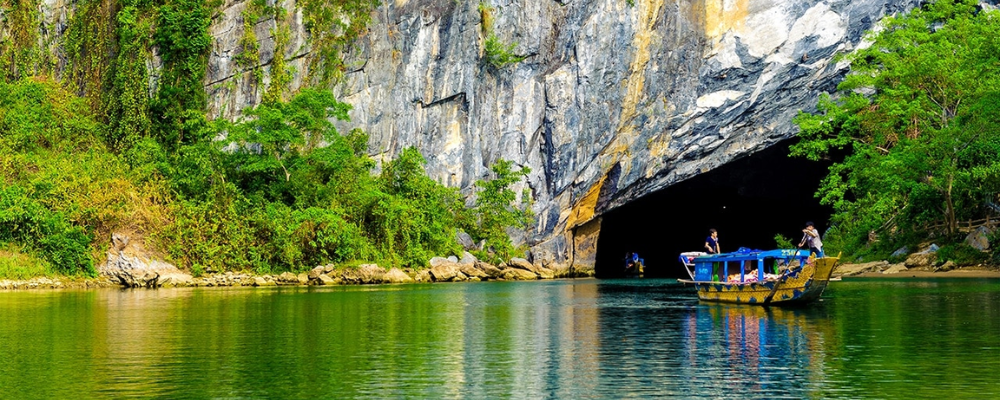
The Botanical Garden is a place where visitors can learn about endemic flora and fauna. The garden displays and preserves specimens of endangered, rare and precious species that need priority protection in Vietnam. People will take a short walk around the botanical garden, visit the Gio waterfall and the wildlife care areas.
Cave system
Quang Binh is known as the "Kingdom of Caves" with hundreds of beautiful, pristine caves, many of which have received world records.
Phong Nha Cave
Phong Nha Cave was formed hundreds of millions of years ago by the weathering process occurring inside the limestone mountains, and was evaluated by the British Royal Cave Expedition as a typical wonder of the aesthetic and geological value of the natural world. According to the explorers, Phong Nha Cave meets 7 criteria: has the most beautiful underground river; has a high and wide cave entrance; has beautiful sand and reef beaches; has a beautiful underground lake; has a large and beautiful dry cave; has a magical and magnificent stalactite system; is the longest water cave.
To explore Phong Nha Cave, visitors get on a boat at Phong Nha Tourist Center and cruise upstream on the Son River for about 30 minutes.
Paradise Cave
Known as the "underground palace", Thien Duong Cave is located about 70 km northwest of Dong Hoi city center, next to the western branch of Ho Chi Minh road and about 25 km from Phong Nha Cave.
Visitors will have to climb more than 500 steps to reach the cave. Passing through the cave entrance is a large space, with countless stalactites and stalagmites. With a length of 31.4 km, Thien Duong Cave is considered the longest dry cave in Asia.
Son Doong Cave
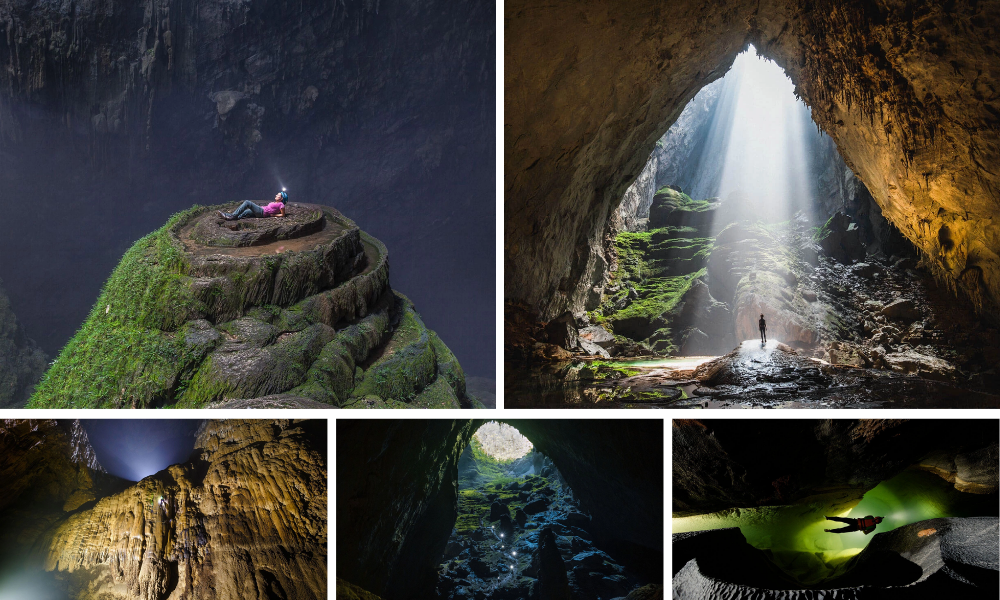
Son Doong Cave is currently the largest natural cave in the world, formed about 2-5 million years ago, 150 m wide, over 200 m high, nearly 9 km long. The estimated volume of Son Doong Cave is 38.5 million m3. The cave's stalactites are 14 m high. There is also a 2.5 km long underground river in the cave. The cave has coral reefs and fossilized animal remains. Son Doong also has two "skylights", two places where sunlight shines, creating conditions for trees to grow like a tropical forest, one of which is called the "garden of Edam".
To visit Son Doong, visitors need to buy a tour, prepare their physical strength, and learn about safety regulations. Tours are available from late January to August every year. The exploration time is 5 days and 4 nights. The average number of guests per tour is 10 people. The tour price is currently 72 million VND per person.
Tu Lan Cave
The Tu Lan cave system is located in a primeval forest and limestone mountains with an area of over 650 hectares in Tan Hoa commune, Minh Hoa district. The Tu Lan cave system was first explored in 1992 by the British-Vietnamese Cave Exploration Group. By 2022, experts had discovered, surveyed and measured more than 25 large and small caves.
Tu Lan is a system formed along the Rao Nan River, located outside the Phong Nha - Ke Bang National Park. The caves in the Tu Lan system include both water caves (with streams flowing inside) and dry caves. Typical caves include Chuot, Hung Ton, Bi Mat, Song, Ken, Kim, and Tien caves. Dry caves often have many beautiful and unique stalactites because they are not washed away during the rainy season. Visitors can swim in the underground cave system, camp in the forest, etc.
Swallow Cave
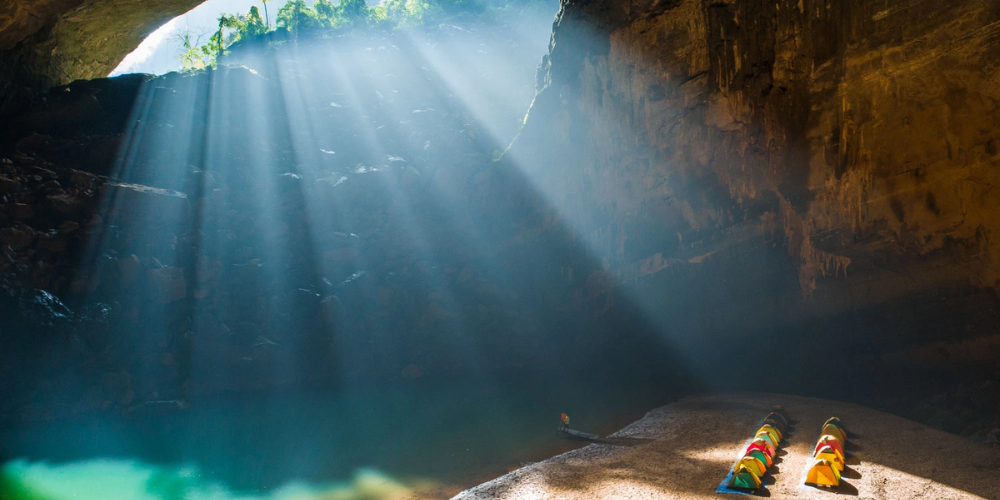
The world's third largest cave, Hang En, is 1.6 km long and cuts through a huge limestone mass. There are three entrances to the cave, the largest and most famous of which is 120 m high and 110 m wide, with a ceiling that is 145 m high and a corridor that is 200 m wide at its widest point. Inside the cave is a winding stream that leads to Son Doong Cave. The Hollywood movie Peter Pan was filmed here.
The tour to explore Hang En is open from December to the end of September every year. The journey to Hang En lasts for two days, with trekking activities such as crossing forests, wading streams, climbing slopes, and exploring Ban Doong - the residence of the Bru - Van Kieu people.
Pygmy Cave
Pygmy Cave is the fourth largest cave in the world, located deep in Phong Nha - Ke Bang National Park, discovered in 1997. The entrance to the cave is about 100 m high and wide, 845 m long. During the day, light can penetrate the cave. The exit of the cave is also a camping site.
In Pygmy Cave, water flows from the ceiling, used for drinking, cooking and daily activities. The light penetrates deep into the cave, helping many ferns grow well. At the exit, visitors can see many vines and bamboos tied together by the locals to climb up the cave wall to harvest bird's nests and honey.
Kong Collapse
Kong Collapse is part of the Tiger Cave system in the Phong Nha - Ke Bang area, shaped like the giant monkey head in the movie Kong: Skull Island, which was filmed in Quang Binh. Kong Collapse is 450 m deep from mouth to bottom, making it one of the deepest sinkholes in the world.
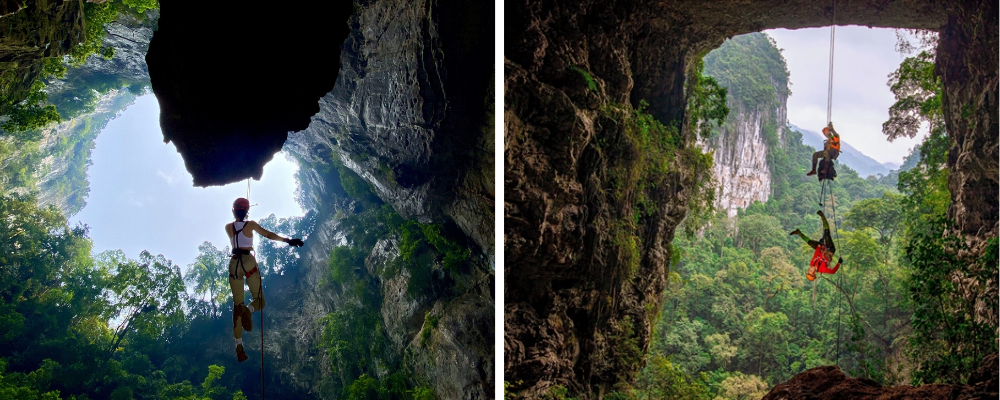
Exploring the Kong sinkhole is currently the most difficult adventure tour in Vietnam, with the experience of ziplining 100m, walking 23km, swimming 300m and exploring a 7km long cave. The journey requires hours of walking through small trails with continuous ups and downs. During the journey, visitors will pass through Pygmy Cave, camp in Over Cave.
River and lake system
Gianh River
Gianh River is considered the geographical symbol of Quang Binh province. The river is 160 km long, originating from the edge of Co Pi mountain, 2,017 m high, in the Truong Son range. Gianh River flows through Minh Hoa, Tuyen Hoa, Quang Trach, Bo Trach districts and flows into the sea at Giang estuary. In addition to Gianh River, Quang Binh has four other main river systems: Roon, Ly Hoa, Dinh and Nhat Le rivers.
Son River

The Son River, also known as Nguon Son, Rao Son, and Trooc River, flows entirely through Quang Binh Province. The upper part of the river is over 7,700 m long, flowing underground in the limestone mountains in the west of Quang Binh. The Son River flows from Phong Nha Cave and joins the Gianh River in Ba Don Town. There are currently day boat tours to see the Son and Gianh Rivers, taking visitors through rustic villages and majestic mountains and forests.
Nhat Le River
Originating from the Truong Son mountain range, the river flows into the East Sea through the Nhat Le estuary. The name Nhat Le means radiant sun. Watching the sunrise by the river is a favorite experience of locals and tourists. Early in the morning, the sun will rise from the Bao Ninh sand dunes, standing on the south bank of the river, visitors will see the sunlight as if it were gilded on the water.
Sea
Nhat Le Beach
Once one of the 10 most attractive beach tourist attractions in Vietnam voted by the General Department of Tourism, Nhat Le beach stretches along Dong Hoi city, about 2 km from the center. White sand, clear blue water and gentle waves are the beauties that attract visitors to the three main beaches of Nhat Le beach.
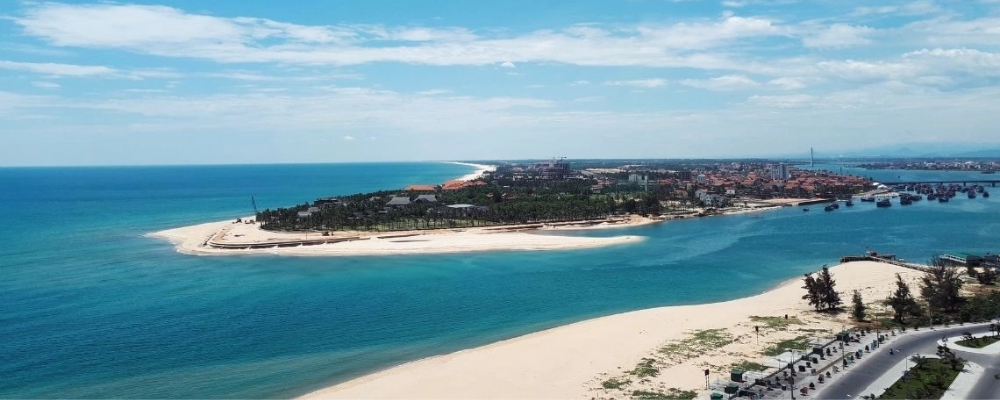
Bao Ninh Peninsula
Located in the east of Dong Hoi City, Bao Ninh Peninsula is peaceful between the sea on one side and Nhat Le River on the other. In addition to swimming and sightseeing, visitors can also participate in a number of sports activities such as volleyball, soccer, kite flying, surfing, and parasailing on the beach. Bao Ninh has a long, smooth, pristine coastline. Bao Ninh Peninsula also has ancient ramparts and Whale Temple with strong fishermen's culture, Truong Sa Rampart, Sa Chuy Fort and Suot Mother Monument...
Jumping Rock Beach
Bai Da Nhay is a scenic spot in Bo Trach district, located on National Highway 1A, about 26 km north of Dong Hoi city. The coastal rocks have been weathered and eroded by seawater over time, creating natural animal statues such as male and female rocks, elephants, tigers... that seem to jump on the waves. If you have time, visitors can also participate in many types of recreational activities such as rowing, mountain climbing, hunting or simply strolling in the coastal pine forest.
The water in the Coc Well at Da Nhay beach is very clear. In particular, the water in the well is warm in winter and cool in summer, and is often used by fishermen to worship at the Nam Hai Dai Vuong temple.
Dong Hoi City

Quang Binh Quan
This is a citadel in the Luy Thay system, built in 1639, to help Lord Nguyen in Dang Trong fight against the attacks of Lord Trinh in Dang Ngoai. Quang Binh Quan was destroyed by the French army when they withdrew from Dong Hoi in 1954, then rebuilt almost as before. In 1965, this place was destroyed by American aircraft. Currently, Quang Binh Quan has been restored to its original state more than three centuries ago.
Tam Toa Church bell tower
Tam Toa Church is located in the center of Dong Hoi City, next to Nhat Le River. The church is about 10 m high. Having gone through many bomb attacks during the war, the church now only has the bell tower in the front and a brick pillar on a stone foundation in the back, but still retains its ancient beauty. This place is one of the provincial historical and cultural heritages.
Dong Hoi Citadel
The citadel is part of the complex of military historical relics of Dong Hoi during the Trinh - Nguyen conflict, built on the key land of the cross-country road from North to South. Today, Dong Hoi citadel is only about 1,100 m long with 15 zigzag sections. The southern citadel is still quite intact, the eastern citadel still has three gates. Although it was destroyed a lot during two wars, the citadel still retains the necessary original elements.
Mother Suot Monument
Mother Suot is the hero Nguyen Thi Suot, born in 1906 in Bao Ninh, Quang Binh. During the years of resistance against the US, Mother Suot volunteered to connect the communication line between Dong Hoi and Bao Ninh, rowing a boat to help soldiers cross the river and transport ammunition. The monument is about 7 m high, located on the banks of Nhat Le River, and is a must-see stop for many tourists.
Ngang Pass
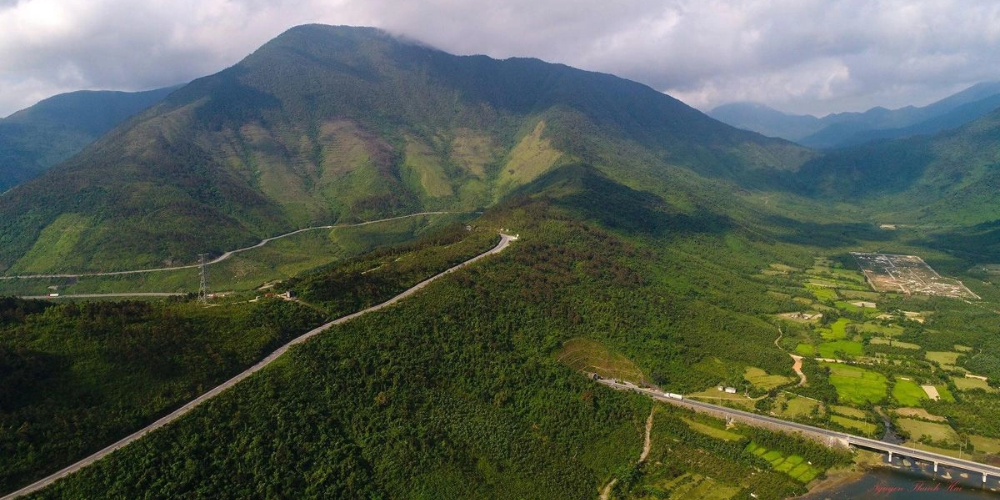
As the natural border between Ha Tinh and Quang Binh provinces, Ngang Pass crosses the Hoanh Son mountain range, a key checkpoint on National Highway 1A. The pass is famous in the poem Qua Deo Ngang by Ba Huyen Thanh Quan. The pass is 6 km long, with a peak of about 250 m. At the top of the pass, there is still "Heaven's Gate" - a relic of the Hoanh Son Quan pass built in 1833. Since 2004, the Deo Ngang road tunnel has been built, replacing the mountain pass section.
Vung Chua - Yen Island

This is a scenic spot in Tho Son village, Quang Dong commune, Quang Trach district, right at the foot of Ngang pass, about 4 km south, more than 2 km east of National Highway 1A. Vung Chua is a peaceful beach, with Yen island in the sea, considered a screen creating a charming scene. Dragon Mountain in this area is the resting place of General Vo Nguyen Giap. Every day, thousands of people from all over the country come here to offer incense, especially crowded during Tet holidays. However, this area will be closed from time to time, visitors need to contact in advance for information.
Chay River - Dark Cave

Chay River originates from the limestone mountains flowing through the villages, combined with Dark Cave, a cave with an ancient stalactite system typical of the geological formation process of Phong Nha - Ke Bang area, forming a natural exploration tourist route. Currently, Chay River - Dark Cave is being exploited in the form of an adventure with many services such as zipline river bathing, zipline cave exploration, kayaking to explore Chay River, swimming through Thuy Tien Lake in Dark Cave and mud baths which are good for health...
Moọc Spring
Moọc Spring tourist area is located in Bo Trach district, about 70 km from Dong Hoi city, on the western branch of Ho Chi Minh road. The stream is located right in the middle of the valley, surrounded by limestone mountains, along the banks of the Chay river. The stream here is green all year round, on sunny summer days, the water is even greener. There are many fun and adventurous activities here such as swimming, kayaking, fishing, ziplining. Visitors must buy entrance tickets and tickets for each game.
All Terrain Vehicle (ATV)
The "Exploring Lim Forest - Kong's Home" tour by 4-wheel all-terrain vehicle (ATV) operates in Tan Hoa commune, Minh Hoa district. This is the place where director Jordan Vogt-Roberts chose as the setting for the 2016 Hollywood blockbuster "Kong: Skull Island". ATV is a multi-functional off-road vehicle that can move on many types of terrain such as steep passes, forests, sand dunes or many obstacles. During the 2-hour tour, visitors will be in control of the route, driving through the forest, conquering every bend, slope, crossing streams and running in dark tunnels.
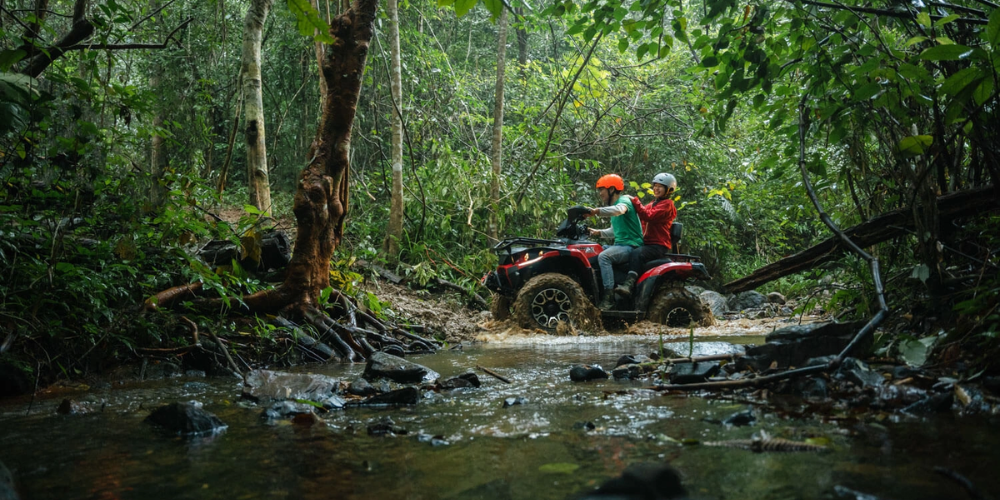
Culture and Local Cuisine
Banh bot loc is a delicacy not to be missed when visiting Dong Hoi. The cake has a shell made from cassava starch, shrimp, fatty meat filling, wrapped in banana leaves. When steamed, the shell is transparent, rich in flavor. Banh bot loc in Quang Binh also has a type filled with mung bean.
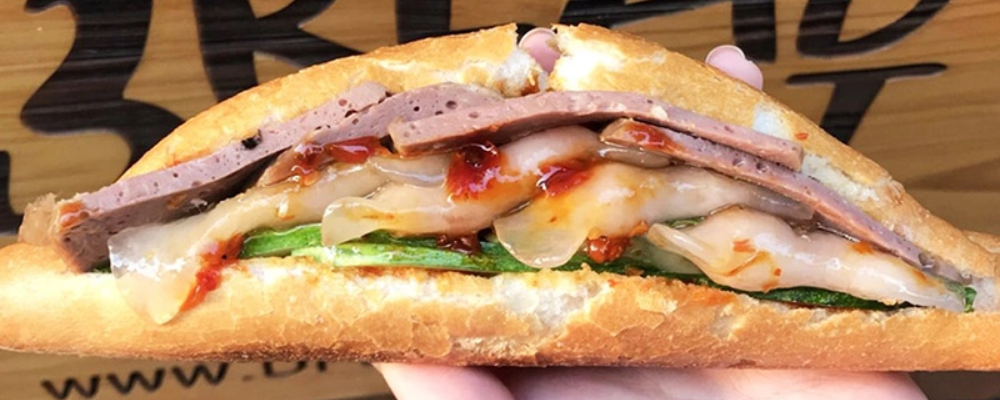
Dong Hoi market banh mi bot loc
Banh mi bot loc is a breakfast dish that combines hot bread with about 7-8 banh bot loc, with sauce and green onions. The dish is sold in Dong Hoi market or street stalls for about 10,000-15,000 VND each.
Chao canh has a rich sweet broth, soft noodles, and a little bit of spicy chopped green vegetables. Besides Dong Hoi city, some other places that have this dish are Ba Don town. Ba Don's Chao canh has a rich taste of sea fish such as mackerel, herring, pomfret... served with crispy fried rice.
Bun cha ca thac lac has a broth made from fish bones or pork bones, served with pickled shallots and sliced chili. The accompanying raw vegetables are lettuce and banana flowers. Each bowl is sold for about 30,000 VND, suitable for breakfast.
Chat chat is a dish of the people living along the Gianh River. Related to mussels, chat chat is only as big as green beans. Quang Binh people create many dishes from stone cakes, stir-fried chat chat, or noodles, porridge, soup or stir-fried young jackfruit.

Oyster porridge is a dish served to guests by the people of Quan Hau town, Quang Ninh district, right at the gateway to Dong Hoi city. Fresh and delicious Nhat Le river oysters, with their fatty taste, create a bowl of rustic porridge, with a sweet aroma and an unforgettable flavor.
Banh khoai is a dish not to be missed when visiting Quang Binh. The cake is similar to banh xeo, but thicker, with beef and fresh shrimp filling. Diners will use rice paper to wrap the banh khoai, with vegetables and dip it in sweet and sour fish sauce.
Seafood in Quang Binh is very rich and reasonably priced, with unique ways of preparation such as fish hotpot, fish salad, steamed crab, ram den, mam lop... Fish salad is usually made from grouper or anchovy. The fish is dipped in lime juice, rolled in rice paper with various ingredients. Fish salad is sold at many seafood restaurants in the center of Dong Hoi city, and restaurants on boats on Nhat Le river.
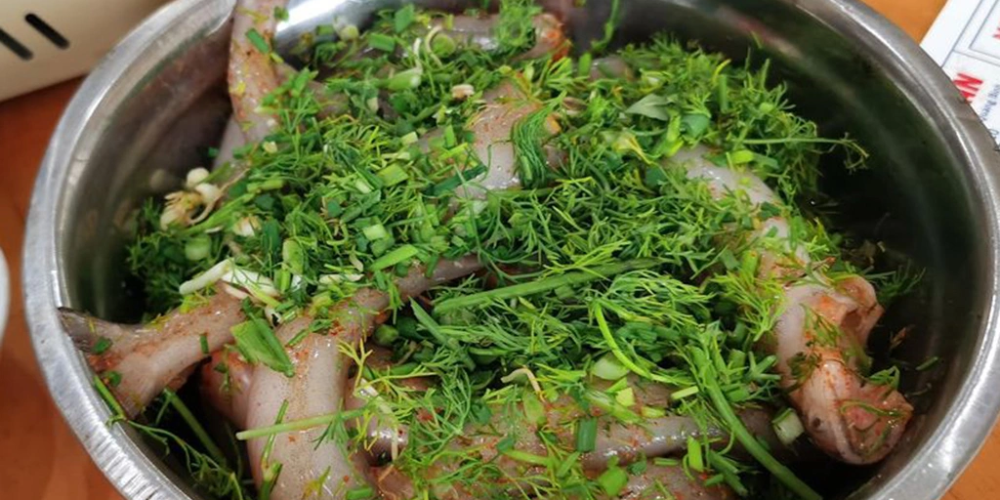
Khoai fish hotpot , also known as fish porridge, is also a specialty sold at many restaurants in Dong Hoi City. The rustic hotpot with tomatoes, star fruit, tamarind leaves, pickled bamboo shoots, and pickled cabbage creates a delicious taste for the soft, melt-in-your-mouth pieces of khoa fish. Diners can order seafood with it.
Melaleuca mushrooms are not available everywhere and in all seasons. This specialty is only available around April and July-August of the lunar calendar, each crop lasts about 5-7 days after each rain. The mushrooms grow on Melaleuca trees, have a bitter taste, and are used to stir-fry with sweet potato leaves, pork, shrimp or cook soup, porridge.
Soft sweet potatoes are made from potatoes that have been harvested and left in water to dry slightly. When the potatoes are less fresh, the surface of the tubers is no longer plump and bright in color, they are washed and boiled, then peeled and thinly sliced, and dried in the strong sunlight for 7 to 9 days to have soft sweet potatoes. Delicious sweet potato slices are amber in color, soft and sweet, with a characteristic sweet potato aroma.
